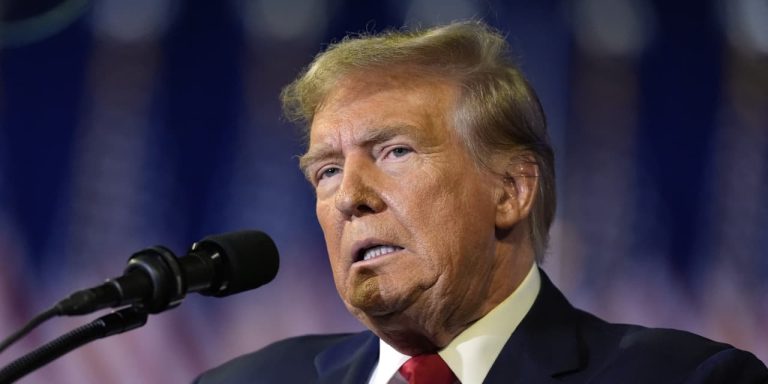If the polls, gamblers and bookmakers are right, Donald Trump will be the Republican nominee for president. And if the polls, gamblers and bookmakers are right, he is also now the favorite to become the next president.
Since whoever is sworn in next January will have to deal with the looming crisis in Social Security and Medicare, this raises the question: What will former and future President Trump do about it?
I have reached out to his campaign, but so far have not heard back.
Trump has been quick during this campaign to criticize rivals for suggesting they would do something to reduce, or even restrict the growth of, spending on Social Security and Medicare. Trump said Florida Gov. Ron DeSantis was “a man in a wheelchair over a cliff,” referring to a famous — or infamous — Democratic attack ad in 2012 about small-government Republicans.
Trump has repeatedly attacked Nikki Haley, his last remaining challenger for the nomination, in the same vein.
“She wants to eliminate Social Security and Medicare and raise the retirement age by 10 years,” he told a crowd in South Carolina this week. Under Healey's Social Security plans, “you have another year, and then you know it's not a year, it's 11 years…and that's what you want to do,” he said.
Actually, Haley didn't say that, or anything like that. As I noted before, Haley's proposals for these programs amount to a lie, and would not affect the retirement age for anyone over the age of 30. But so what? What matters these days is not what is actually true, but what people believe. However, politically, this point may be moot.
As my late father used to say, it's easier to be a first-rate critic than a third-rate musician. Or as Teddy Roosevelt said: “It is not the critic who is important… but the man who is actually in the arena.”
So the question is not whether Donald Trump can criticize others for coming up with ideas to help balance the books on Social Security and Medicare. Anyone can do it.
Rather, it is a question of whether Trump, the current front-runner to become the Republican nominee – and perhaps president – has a plan of his own.
If he is sworn in next January, he will likely have a Republican Congress to work with. Trump's second term is scheduled to last until January 2029. What will he and his Republican allies on Capitol Hill do for Social Security and Medicare during that period?
It's urgent. By the time Trump is scheduled to leave office, the Social Security Trust Fund will be just four years away from bankruptcy. Medicare confidence will only be two years away. Unless the necessary measures are taken, the result will be a catastrophic collapse in benefits.
In other words, unless Trump and Congress can agree on a plan to save these two programs, retirees can expect exactly the doomsday scenario the Trump campaign was trying to pin on Haley: a 20% cut in Social Security checks, across the board. It does not exclude those already retired or those approaching retirement.
The problem that very few people realize is that the crisis facing these two programs is part of the broader crisis facing the federal government. There are no separate crises facing “deficits” and “entitlements.” They are the same thing. Trusts are just accounting fictions.
The latest news is grim. The US Government Accountability Office warned this week that “the federal government faces an unsustainable fiscal trajectory over the long term.” He estimates that the national debt “will double over the next 30 years” as a share of the economy according to current trends. He adds that this “poses serious economic, security and social challenges if not addressed.”
“The level of federal debt is growing at a rate that threatens the vitality of our nation’s economy and the safety and well-being of the American people,” Gene Dodaro, comptroller general of the U.S. government and head of the Government Accountability Office, said in a statement.
Most of the growth in government spending comes from just three things, says Maya McGuinius, chair of the nonpartisan Committee for a Responsible Federal Budget: Social Security, health care including Medicare, and interest on the debt. “Over the next 10 years, growth in benefits, Social Security and Medicare will account for 85% of spending growth,” she told me.
It's shocking how quickly we got here. In 2000, the US national debt was only $3.4 trillion, or about a third of annual gross domestic product. At the time, the Congressional Budget Office predicted that it would be completely eliminated within a decade.
Today it is worth $24 trillion, or nearly 100% of GDP, the Government Accountability Office reports. This is the highest level since World War II. On the current path, it will reach 200% of GDP by 2050.
The best that can be said is that the deficit over the next 10 years will be lower than projected last year, largely due to a booming jobs market and spending limits agreed upon between President Biden and Congress.
What will Trump do? We know one thing: it will make this deficit larger. Trump promises that if elected he will extend his 2017 tax cuts, which are set to expire next year. He says he will cut taxes further. “I gave you the largest tax cuts in the history of our country,” he told South Carolinians this week. “I will make the Trump tax cuts permanent…and we will lower your taxes even more.” [See here, starting at 13 minutes and 30 seconds.]
McGinnis tells me that Trump's initial tax cuts in 2017 added $2 trillion to the debt, and extending them would add another $3 trillion. And by the way, that would be $3 trillion On top Among the deficit numbers that the Central Bank of Oman and the Government Accountability Office talk about.
Lower taxes are great in many ways, especially for anyone who works for a living. But there is a recurring myth that tax cuts “pay for themselves.” Some people seem to think of Ronald Reagan's famous Laffer Curve, which was all about cutting punitive Tax rates of 70%, 80%, or 90% are really just the Laffer line, which will be about lowering taxes. any Tax rates. The logical implication of this stupidity is that we can maximize revenues by cutting taxes to zero. (Good luck with that.)
There's a modern word for this kind of nonsense: “cookie.” As in: Wanting to have your cake and eat it. This applies to the person who says you don't have to make any hard choices. They will cut taxes and protect spending plans, even if the government is already deep in a hole. Charm! Oh, and did you hear about the awesome new diet where you can eat all the pizza, nachos, and chocolate cake you want, and still lose weight?
In fact, the initial point of the Laffer curve is a happy mean, where tax rates are reasonable and revenues are high. Raising tax rates to too high levels hurts government revenues just as much as cutting them to too low levels.
Whatever your opinion of Trump's 2017 tax cuts, they did not help relieve debt. When federal government revenues were adjusted for inflation, they actually declined after passage. (In 2020 it was lower, in real terms, than in 2016 or even 2017).
This was also true of the Bush tax cuts in 2001 that began our national path to financial ruin. Adjusted for inflation, total federal tax revenues collapsed after these cuts, and remain low A decade later. The myth of a no-cost tax cut is just that: a myth.
Trump has floated some interesting ideas for generating government revenue, such as licensing more oil and gas drilling on federal lands, and imposing huge tariffs on imports from places like China. (The latter, by the way, is an idea once supported by Democrats like New York Sen. Chuck Schumer.)
The problem, CRFB points out, is that the numbers don't match. Even an optimistic view of Trump's tariffs sees them raising perhaps $2 trillion over the next 10 years — two-thirds of estimates simply for the cost of extending his 2017 tax cuts.
Not long ago, when I asked the Trump campaign about his plans for Social Security and Medicare, they directed me to the website. There I found suggestions that Trump would plug funding gaps by cutting international aid, deporting illegal immigrants, ending “leftist gender programs” in the military, cutting “billions spent on climate extremism,” and cutting “waste, fraud, waste, and fraud.” And abuse is everywhere we can find it.
Funding gaps in the two programs are currently estimated at $27 trillion, or about $130,000 per working-age American.
As Trump inches closer to his party's nomination, and perhaps re-election to the White House, he owes us a fuller explanation of what, if anything, he intends to do.


